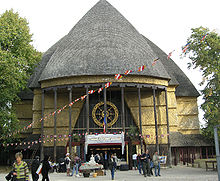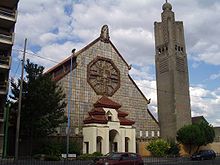- Paris Colonial Exposition
-
The Paris Colonial Exhibition (or "Exposition coloniale internationale", International Colonial Exhibition) was a six-month colonial exhibition held in Paris, France in 1931 that attempted to display the diverse cultures and immense resources of France's colonial possessions.
Contents
History
The exposition opened on 6 May 1931 in the Bois de Vincennes on the eastern outskirts of Paris.[1] The scale was enormous;[2] Sculptor Elizabeth Prophet called it "the most spectacular colonial extravaganza ever staged in the West."[3] Some 33 million visitors came from around the world.[2] The French government brought people from the colonies to Paris and had them create native arts and crafts and perform in grandly scaled reproductions of their native architectural styles such as huts or temples.[4] Other nations participated in the event, including The Netherlands, Belgium, Italy, Japan, Portugal, the United Kingdom, and the United States.[2] The exhibition included a "human zoo," displaying nomadic Senegalese Villages.[5]
Politically, France hoped the exposition would paint its colonial empire in a beneficial light, showing the mutual exchange of cultures and the benefit of France's efforts overseas. This would thus negate German criticisms that France was "the exploiter of colonial societies [and] the agent of miscegenation and decadence". The exposition highlighted the endemic cultures of the colonies and downplayed French efforts to spread its own language and culture abroad, thus advancing the notion that France was associating with colonised societies, not assimilating them.[4]
The Colonial Exposition provided a forum for the discussion of colonialism in general and of French colonies specifically. French authorities published over 3,000 reports during the six-month period and held over 100 congresses. The exposition served as a vehicle for colonial writers to publicise their works, and it created a market in Paris for various ethnic cuisines, particularly North African and Vietnamese. Filmmakers chose French colonies as the subjects of their works. The Permanent Colonial Museum (today the Musée des Arts Africains et Océaniens) opened at the end of the exposition. The colonial service experienced a boost in applications.[4]
26 territories of the empire participated in the Colonial Exposition Issue of postage stamps issued in conjunction with the Exposition.
Communist counter-exhibition
At the request of the Comintern, a smaller counter-exhibition entitled The Truth on the Colonies, organized by the Communist Party and the CGTU, attracted very few visitors (5000 in 8 months)[6]. The first section was dedicated to abuses committed during the colonial conquests, and quoted Albert Londres and André Gide's criticisms of forced labour in the colonies while the second one made an apology of the Soviets' "nationalities' policy" compared to "imperialist colonialism".
 Counter exhibition to the 1931 Colonial Exhibition in Paris, organized by the PCF. Titled Truth on the Colonies
Counter exhibition to the 1931 Colonial Exhibition in Paris, organized by the PCF. Titled Truth on the Colonies
Posterity
Certain of these buildings were preserved or moved:
- Palais de la Porte Dorée, Former-musée national des Arts d'Afrique et d'Océanie, current Cité nationale de l'histoire de l'immigration, porte Dorée in Paris, constructed from 1928 to 1931 by the architects Albert Laprade, Léon Bazin and Léon Jaussely.
- The foundations of the Parc zoologique de Vincennes
 Pavillon du Togo by Louis-Hippolyte Boileau in bois de Vincennes
Pavillon du Togo by Louis-Hippolyte Boileau in bois de Vincennes
- The Pagode de Vincennes, on the edges of the lake Daumesnil, in the former houses of Cameroon and Togo of Louis-Hippolyte Boileau: Photo
- The church Notre-Dame des Missions was moved to Épinay-sur-Seine (95) in 1932.
- The reproduction of Mount Vernon, house of George Washington, moved to Vaucresson
where it is still visible.
See also
Notes
- ^ Leininger-Miller 54–5.
- ^ a b c Leininger-Miller 54.
- ^ Diary, 14 July 1931, quoted in Leininger-Miller 55.
- ^ a b c Leininger-Miller 55.
- ^ On the 1931 Colonial Exposition in Paris
- ^ Études coloniales 2006-08-25 "L'Exposition coloniale de 1931 : mythe républicain ou mythe impérial" (in French)
References
- Leininger-Miller, Theresa A., New Negro Artist in Paris: African American Painters & Sculptors in the City of Light, 1922–1934. Piscataway, New Jersey: Rutgers University Press, 2001.
- Hodeir, Catherine, 1931, l'exposition coloniale. Paris: Editions Complexe, 1991. ISBN 2870273827.
Further reading
- Morton, Patricia A., Hybrid Modernities: Representation and Architecture at 1931 International Colonial Exposition in Paris. Cambridge, Massachusetts: MIT Press, 2000.
- Geppert, Alexander C.T., Fleeting Cities. Imperial Expositions in Fin-de-Siècle Europe, Basingstoke/New York: Palgrave Macmillan, 2010. ISBN 9780230221642.
Categories:- Colonialism
- French West Africa
- French Equatorial Africa
- French Indochina
- French Third Republic
- 1931 in France
- 20th century in Paris
- Colonial exhibitions
Wikimedia Foundation. 2010.



